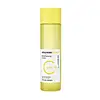What's inside
What's inside
 Key Ingredients
Key Ingredients

 Benefits
Benefits

 Concerns
Concerns

 Ingredients Side-by-side
Ingredients Side-by-side

Water
Skin ConditioningAlcohol Denat.
AntimicrobialBis-PEG-18 Methyl Ether Dimethyl Silane
EmollientButylene Glycol
HumectantGlycereth-26
HumectantPortulaca Oleracea Extract
Skin ConditioningHydrolyzed Collagen
EmollientPEG-240/Hdi Copolymer Bis-Decyltetradeceth-20 Ether
StabilisingBetaine
HumectantDipropylene Glycol
HumectantCarbomer
Emulsion StabilisingMethylparaben
PreservativePEG-60 Hydrogenated Castor Oil
EmulsifyingPhenoxyethanol
PreservativeTrehalose
HumectantTriethanolamine
BufferingSodium Hyaluronate
HumectantXanthan Gum
EmulsifyingDisodium EDTA
Parfum
MaskingWater, Alcohol Denat., Bis-PEG-18 Methyl Ether Dimethyl Silane, Butylene Glycol, Glycereth-26, Portulaca Oleracea Extract, Hydrolyzed Collagen, PEG-240/Hdi Copolymer Bis-Decyltetradeceth-20 Ether, Betaine, Dipropylene Glycol, Carbomer, Methylparaben, PEG-60 Hydrogenated Castor Oil, Phenoxyethanol, Trehalose, Triethanolamine, Sodium Hyaluronate, Xanthan Gum, Disodium EDTA, Parfum
Actinidia Chinensis Fruit Extract
EmollientButylene Glycol
HumectantGlycerin
HumectantWater
Skin ConditioningArbutin
AntioxidantNiacinamide
Smoothing1,2-Hexanediol
Skin ConditioningAscorbic Acid
AntioxidantActinidia Chinensis Seed Oil
EmollientCarnitine
Cleansing4-Butylresorcinol
AntioxidantAleuritic Acid
Skin ConditioningYeast Extract
Skin ConditioningGlycoproteins
Skin ConditioningSodium Ascorbyl Phosphate
AntioxidantBiotin
AntiseborrhoeicPanthenol
Skin ConditioningThiamine Hcl
MaskingCyanocobalamin
Skin ConditioningRiboflavin
Cosmetic ColorantPyridoxine
Skin ConditioningFolic Acid
Skin ConditioningMenadione
MaskingBioflavonoids
Skin ConditioningTocopheryl Acetate
AntioxidantGlutathione
Betaine
HumectantPolyquaternium-51
Skin ConditioningGlyceryl Polymethacrylate
Sodium Hyaluronate
HumectantLecithin
EmollientPolyglyceryl-10 Oleate
Skin ConditioningPPG-13-Decyltetradeceth-24
EmulsifyingCaprylic/Capric Triglyceride
MaskingCyamopsis Tetragonoloba Gum
Emulsion StabilisingAgar
MaskingXanthan Gum
EmulsifyingAcrylates/C10-30 Alkyl Acrylate Crosspolymer
Emulsion StabilisingTromethamine
BufferingAllantoin
Skin ConditioningChitosan
Polymethyl Methacrylate
Ammonium Acryloyldimethyltaurate/Vp Copolymer
Melia Azadirachta Leaf Extract
Skin ConditioningMelia Azadirachta Flower Extract
Skin ConditioningOcimum Sanctum Leaf Extract
Skin ConditioningCurcuma Longa Root Extract
MaskingCorallina Officinalis Extract
Skin ConditioningEthylhexylglycerin
Skin ConditioningDisodium EDTA
Adenosine
Skin ConditioningParfum
MaskingLimonene
PerfumingActinidia Chinensis Fruit Extract, Butylene Glycol, Glycerin, Water, Arbutin, Niacinamide, 1,2-Hexanediol, Ascorbic Acid, Actinidia Chinensis Seed Oil, Carnitine, 4-Butylresorcinol, Aleuritic Acid, Yeast Extract, Glycoproteins, Sodium Ascorbyl Phosphate, Biotin, Panthenol, Thiamine Hcl, Cyanocobalamin, Riboflavin, Pyridoxine, Folic Acid, Menadione, Bioflavonoids, Tocopheryl Acetate, Glutathione, Betaine, Polyquaternium-51, Glyceryl Polymethacrylate, Sodium Hyaluronate, Lecithin, Polyglyceryl-10 Oleate, PPG-13-Decyltetradeceth-24, Caprylic/Capric Triglyceride, Cyamopsis Tetragonoloba Gum, Agar, Xanthan Gum, Acrylates/C10-30 Alkyl Acrylate Crosspolymer, Tromethamine, Allantoin, Chitosan, Polymethyl Methacrylate, Ammonium Acryloyldimethyltaurate/Vp Copolymer, Melia Azadirachta Leaf Extract, Melia Azadirachta Flower Extract, Ocimum Sanctum Leaf Extract, Curcuma Longa Root Extract, Corallina Officinalis Extract, Ethylhexylglycerin, Disodium EDTA, Adenosine, Parfum, Limonene
 Reviews
Reviews

Ingredients Explained
These ingredients are found in both products.
Ingredients higher up in an ingredient list are typically present in a larger amount.
Betaine is a common humectant (a substance that promotes retention of moisture). It's known to be gentle on the skin and can help balance hydration.
This ingredient is best for improving hydration and soothing irritated skin. Studies also show it helps even out skin tone.
Fun fact: Betaine is naturally created in the skin and body. The kind found within cosmetic products can be either plant-derived or synthetic.
Another name for betaine is trimethylglycine.
Learn more about BetaineButylene Glycol (or BG) is used within cosmetic products for a few different reasons:
Overall, Butylene Glycol is a safe and well-rounded ingredient that works well with other ingredients.
Though this ingredient works well with most skin types, some people with sensitive skin may experience a reaction such as allergic rashes, closed comedones, or itchiness.
Learn more about Butylene GlycolDisodium EDTA plays a role in making products more stable by aiding other preservatives.
It is a chelating agent, meaning it neutralizes metal ions that may be found in a product.
Disodium EDTA is a salt of edetic acid and is found to be safe in cosmetic ingredients.
Learn more about Disodium EDTAParfum is a catch-all term for an ingredient or more that is used to give a scent to products.
Also called "fragrance", this ingredient can be a blend of hundreds of chemicals or plant oils. This means every product with "fragrance" or "parfum" in the ingredients list is a different mixture.
For instance, Habanolide is a proprietary trade name for a specific aroma chemical. When used as a fragrance ingredient in cosmetics, most aroma chemicals fall under the broad labeling category of “FRAGRANCE” or “PARFUM” according to EU and US regulations.
The term 'parfum' or 'fragrance' is not regulated in many countries. In many cases, it is up to the brand to define this term.
For instance, many brands choose to label themselves as "fragrance-free" because they are not using synthetic fragrances. However, their products may still contain ingredients such as essential oils that are considered a fragrance by INCI standards.
One example is Calendula flower extract. Calendula is an essential oil that still imparts a scent or 'fragrance'.
Depending on the blend, the ingredients in the mixture can cause allergies and sensitivities on the skin. Some ingredients that are known EU allergens include linalool and citronellol.
Parfum can also be used to mask or cover an unpleasant scent.
The bottom line is: not all fragrances/parfum/ingredients are created equally. If you are worried about fragrances, we recommend taking a closer look at an ingredient. And of course, we always recommend speaking with a professional.
Learn more about ParfumSodium Hyaluronate is hyaluronic acid's salt form. It is commonly derived from the sodium salt of hyaluronic acid.
Like hyaluronic acid, it is great at holding water and acts as a humectant. This makes it a great skin hydrating ingredient.
Sodium Hyaluronate is naturally occurring in our bodies and is mostly found in eye fluid and joints.
These are some other common types of Hyaluronic Acid:
Learn more about Sodium HyaluronateWater. It's the most common cosmetic ingredient of all. You'll usually see it at the top of ingredient lists, meaning that it makes up the largest part of the product.
So why is it so popular? Water most often acts as a solvent - this means that it helps dissolve other ingredients into the formulation.
You'll also recognize water as that liquid we all need to stay alive. If you see this, drink a glass of water. Stay hydrated!
Learn more about WaterXanthan gum is used as a stabilizer and thickener within cosmetic products. It helps give products a sticky, thick feeling - preventing them from being too runny.
On the technical side of things, xanthan gum is a polysaccharide - a combination consisting of multiple sugar molecules bonded together.
Xanthan gum is a pretty common and great ingredient. It is a natural, non-toxic, non-irritating ingredient that is also commonly used in food products.
Learn more about Xanthan Gum